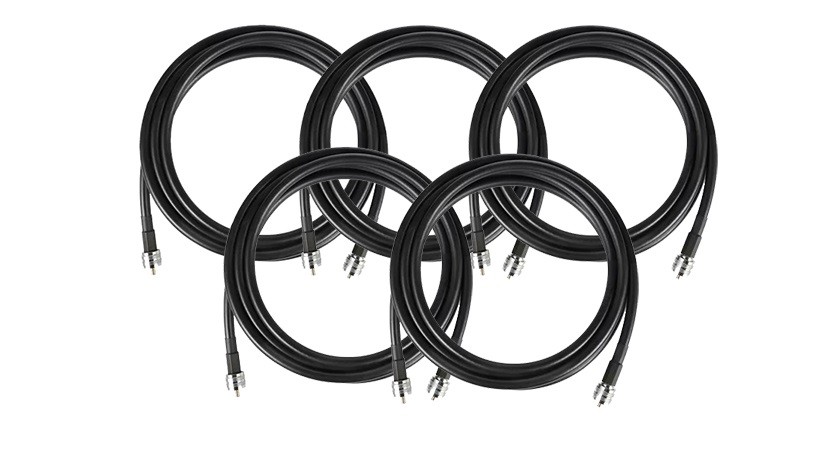RG59 VS RG6 Coaxial Cables: Difference and Usage
RG59 and RG6 are the two most widely used coax cables in today’s market. Both cables are used for various applications and knowing the difference between the two is very important. Here we will discuss each cable in detail so you will be able to make the right choice for your applications.
What is RG?
RG stands for “Radio Guide” and is used to differentiate between the various types of coaxial cables. It was originally developed for US Military communications but today it is widely used to provide television signals and broadband internet connections.
The number that follows RG signifies the cable specification but it doesn’t always refer to thickness or size of the cable. Over the years, there have been dozens of coaxial cables developed but the most popular cables are the RG59 and RG6.

Fun fact!
Did you know that the first closed-circuit transmission of video signals through television was done using coaxial cables? It happened back in 1936 during the Summer Olympics, from Berlin to Leipzig.
What is RG59 Cable?
The RG59 cable has been around for many years. RG59 is commonly used to deliver video signal for cable TV, security cameras and CCTV connections. Most older homes and commercial buildings will tend to have this type of cable.
What is RG6 Cable?
The RG6 cable is one of the most common of the coaxial cables. It is used for many higher frequency applications such as cable TV, HDTV, satellite or broadband internet. It can transmit both audio and video signals.
How To Tell The Difference
Although RG59 looks similar to RG6, you can tell the difference by the size of the diameter. The RG59 cable has an outer diameter which is slightly smaller than RG6. Once you strip the cable, you can clearly see the difference.
The RG6 is a thicker coaxial cable than the RG59. The difference in diameter results from a thicker center conductor of the RG6 cable as well as the shielding within the rubber sheath. Because the RG6 cable is thicker, it has less flexibility than the RG59.
Comparison of RG59 & RG6
| RG59 | RG6 | |
|---|---|---|
| Core Conductor | 20 AWG | 18 AWG |
| Impedance | 75 Ohm | 75 Ohm |
| Bandwidth | Up to 1 GHz | Up to 3 GHz |
| Insulation | Thinner | Thicker |
| Shield | Braided Shield Only | Aluminum Foil Shield & Braided shield |
| Max Distance | 500ft | 1000ft |
| Usage | CCTV and other analog video signals | CATV, satellite, TV antenna, or broadband internet |
| Cost | $$ | $$$ |
Both the RG59 and RG6 cables have center conductor, a shield, a dielectric, and a PVC jacket. Unless you are an expert, you won’t be able to tell the difference between them, as far as the construction goes. They basically look the same but here we will go into more detail.
The RG59 cable is made with a single layer of shielding and 20AWG center conductor . This shielding is made of aluminum and braid shields. Its braided insulation protects the cable from lower-frequency interference. Because it has a smaller conductor, it tends to be on the low-end regarding signal quality compared to the RG6.
The RG6 cable is made with double shielding and an 18AWG center conductor. It offers better signal quality and performance because of the larger conductor size. Its double shielding comprises of foil shield and braided aluminum shield that helps protect it from environmental elements and eliminates signal interference.
Because it has a thicker conductor, the RG6 Cable can provide more extended distance proficiency and better bandwidth. RG6 cable also available with quad shielding . Learn more about Dual vs Quad Shield RG6 Coaxial Cable.
RG59 & RG6 Signal Loss
| Frequency | RG59 signal loss per 100ft | RG6 signal loss per 100ft |
|---|---|---|
| Loss at 50 MHz: | 2.4 dB | 1.5 dB |
| Loss at 100 MHz: | 3.4 dB | 2.0 dB |
| Loss at 400 MHz: | 7.0 dB | 4.3 dB |
| Loss at 900 MHz: | 11.1 dB | 6.8 dB |
| Loss at 1000 MHz: | 12.0 dB | 7.0 dB |
Signal loss is related to the shielding of the coax cable. The better the shielding, the less signal interference there will be. Typically, coaxial cables contain two types of shielding – braided mesh and foil.
Just remember, the longer your cable the more signal loss you will experience. Try to keep your installation lengths as short as possible.
The RG59 cable has single braided shielding. It can handle moderate signal levels over shorter distances without significant loss of signal quality or picture resolution. It is suitable for frequencies below 50MHz.
The RG6 cable incorporates both braided mesh and foil shielding which helps prevent signal interference. This cable is better suited for longer distances without signal loss and works best with frequencies over 50MHz. Anything lower than 50MHz may cause signal degradation.
Connectors:
Is there a difference between RG59 and RG6 connectors? While both the RG59 and RG6 coax cables are compatible with F-type connectors, they are not interchangeable. The reason being is that the RG6 cables outer diameter is larger in size than the RG59 cable. If you will be installing the connectors yourself, make sure you know what cable you have and also be sure to get the right crimping tool.
Are RG59 And RG6 Interchangable?

No. From this article, it should be clear that these two cables are very different. Each one has different properties for performance, frequency levels and applications. The RG 59 coaxial cable is only suitable for low-frequency applications such as analog TV transmission and data transmissions below 50MHz. While RG6 coaxial cables provide better signal quality over longer distances above 50MHz. Therefore, the RG59 and RG6 are not interchangeable.
Can I use RG6 cable for CCTV?
Yes. RG6 can be used for cameras especially if cameras placed far from each other.
Can I use RG59 for my satellite TV?
No. RG6 is designed for high frequency needed for satellite TV.
Can I run coax cable near power lines?
Keep coax at least six inches away from electric cable. You can cross electric cable with the coax, but don't run them close together and parallel to each other.Otherwise its subject for the signal interference.
Conclusion:
Many articles state that RG6 is a better cable, it’s not exactly true because each cable is made for its specific application. It is important that you choose the correct coaxial cable that best suits your needs and budget. Choosing the wrong one, may result in weaker signal quality and poor performance. It’s always better to make an informed decision before you purchase.














































